Metal Detector Accessories
When you get your first metal detector all of a sudden you realize you need other metal detecting accessories.
You need a digger of some sort, ground cloth and a pouch to put the trash and treasures that you find in. You don't need to buy all of this stuff now, but something to think about.
Here is a list and photos of the items we have used and continue to use while land or beach hunting.
Digging Tools
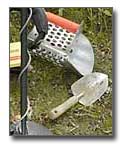 You need some sort of digging tool to dig with. We started out with just a basic garden trowel, and then graduated to a hunting knife that we bought at an Army Navy Store.
You need some sort of digging tool to dig with. We started out with just a basic garden trowel, and then graduated to a hunting knife that we bought at an Army Navy Store.
Now days they have some pretty fancy digging tools. Some have a saw like action on one side for getting at tree roots, and even have markings on them in inches to let you know how deep you're digging.
Ground Cloths
 If you plan on digging dirt, then a ground cloth can be a very helpful item in recovering your target. Where do you get a ground cloth? Make one. We used a pair of old jeans cut them above the thigh and above the knee, then cut it along the seam.
If you plan on digging dirt, then a ground cloth can be a very helpful item in recovering your target. Where do you get a ground cloth? Make one. We used a pair of old jeans cut them above the thigh and above the knee, then cut it along the seam.
The jean material has proven to be very durable too, as you can see. We stapled on two pieces of wood to the cloth to make dumping the dirt easier, but make sure the staples are small enough that your detector doesn't detect them.
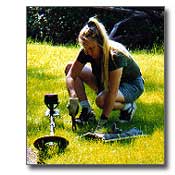 Here's
how you use it. When you cut a flap in the grass, and start scooping out dirt, plop it on your ground cloth that is laying close by. Then scan your dirt to see if you got the target, or if it's still in the hole. Once you locate the target, pick up your ground cloth carefully from the sides with the dirt still on it, and pour the dirt back into the hole, press the grass flap back down, and step on it to secure it. How simple!
Here's
how you use it. When you cut a flap in the grass, and start scooping out dirt, plop it on your ground cloth that is laying close by. Then scan your dirt to see if you got the target, or if it's still in the hole. Once you locate the target, pick up your ground cloth carefully from the sides with the dirt still on it, and pour the dirt back into the hole, press the grass flap back down, and step on it to secure it. How simple!
And you don't leave any telltale signs of you having been there either, no dirty grass! Once you start using one, it's hard to go without one. If you don't use one, your target will likely fall out of your dirt, and then you will have to locate it again in the surrounding grass or leaves.
Garrett Pocket Probe
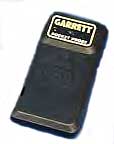 The only reason we have this Garrett probe is because we won it at a club hunt. It has come in handy especially in the woods, where you have to deal with a lot of roots. Also it's nice to use it in places where you don't want to dig a hole like on a well manicured lawn.
The only reason we have this Garrett probe is because we won it at a club hunt. It has come in handy especially in the woods, where you have to deal with a lot of roots. Also it's nice to use it in places where you don't want to dig a hole like on a well manicured lawn.
Just put the probe next to the ground to find the target, and then pop the coin out with a blunt edged screwdriver. It locates targets to several inches down, so you'll know exactly where to dig. There is a spot for headphones on it, like the small kind. But who wants to be switching headphones all the time. It runs on a 9 volt battery.
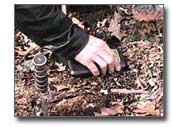 It's difficult to pinpoint items deep in the ground unless you have a hole big enough to fit it in. We tried it at the beach once, and got sand in the button you push to turn it on. It got stuck and we had to take it apart and clean it out. This unit makes a pretty loud sound, so it was strange using it when other people were around. It draws more attention to what you're doing.
It's difficult to pinpoint items deep in the ground unless you have a hole big enough to fit it in. We tried it at the beach once, and got sand in the button you push to turn it on. It got stuck and we had to take it apart and clean it out. This unit makes a pretty loud sound, so it was strange using it when other people were around. It draws more attention to what you're doing.
Whites Electronics sells an probe called a Bullseye pinpointer. You can actually even use an item that construction workers use to find nails behind sheetrock, called a stud finder.
Heavy Duty Beach Sand Scoop
 We bought this beach sand scoop on Ebay for $18.00. We like it and use it alot. It has held up pretty good no matter what we do to it. Carol likes the comfortable plastic grip on it, yet she still wears a glove on her hand to keep from getting a blister by the metal piece on top.
We bought this beach sand scoop on Ebay for $18.00. We like it and use it alot. It has held up pretty good no matter what we do to it. Carol likes the comfortable plastic grip on it, yet she still wears a glove on her hand to keep from getting a blister by the metal piece on top.
We prefer these round holes in the scoop, versus the sand scoops that have square holes. We have two of these scoops now, one for me and one for her.
 We originally started out with a dry sand scoop that had a 3 foot handle on it, but the handle bent. I cut the bent piece off but it is too heavy to use as a dry beach sand scoop so it's sitting in the storage.
We originally started out with a dry sand scoop that had a 3 foot handle on it, but the handle bent. I cut the bent piece off but it is too heavy to use as a dry beach sand scoop so it's sitting in the storage.
We tried making us a scoop out of a large grain scoop we got at a feed store by drilling some holes in it, but it didn't last very long. Also make sure the beach scoop you buy is stainless steel, not galvanized.
Treasure Hunting Pouches
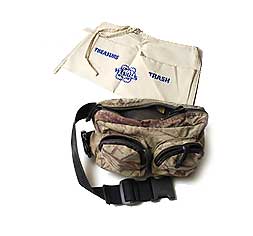 I guess we need to say something here about what we've been using to put our trash and treasures in when we go out treasure hunting. We started out using a carpenter's 2 pocket pouch or apron. They are really cheap, just a couple bucks at the hardware store, and they tie around your waist.
I guess we need to say something here about what we've been using to put our trash and treasures in when we go out treasure hunting. We started out using a carpenter's 2 pocket pouch or apron. They are really cheap, just a couple bucks at the hardware store, and they tie around your waist.
Then we kind of graduated to fanny packs, which seems to be our favorite choice because they zip up. Several times we've been fortunate enough to find some camouflage hunting pouches in the Sports Dept. at Walmart. Several times in the woods we have just used the pockets on our camouflage pants.
Also, if we know we are going to a beach that is pretty well trashed, we take along some plastic grocery bags to drop the big trash and aluminum cans in to take out with us, then if you get stopped by cops or someone questions what you're doing, you can show them how much trash you picked up. They like that.
Metal Detecting Headphones
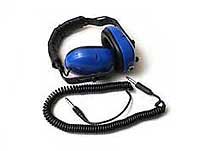 Here's an item we forgot to mention. Headphones are a must! Sometimes when you buy a metal detector the dealer will throw a pair of headphones in with it, but sometimes not. If you ask, they just may do it.
Here's an item we forgot to mention. Headphones are a must! Sometimes when you buy a metal detector the dealer will throw a pair of headphones in with it, but sometimes not. If you ask, they just may do it.
We've used all kinds of headphones, some are expensive, like the Jolly Roger made by Detector Pro. Whites also have exclusive headphones. But you can easily get some starter headphones at Radio Shack for about $15.00.
Make sure they have volume control, and stereo would be nice. Our favorites headphones are called The Big Blues, made in England by Maz
Detectors. The Big Blues are soundproof and well worth the 60 bucks.
Flashlights or Headlamps
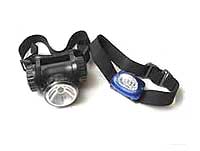 Once you get out to hunt and start finding good stuff, you're not going to want to leave once it starts getting dark, especially in the summer. So get yourself a headlamp and some flashlights. There are some small flashlights that you can clip on to your ballcap or shirt.
Once you get out to hunt and start finding good stuff, you're not going to want to leave once it starts getting dark, especially in the summer. So get yourself a headlamp and some flashlights. There are some small flashlights that you can clip on to your ballcap or shirt.
They have some headlamps that are waterproof, like the larger one in the picture, but they tend to get heavy after awhile. The smaller one is an LED headlamp and it shines a blue light, so you can't really see that good with it, but the batteries last a long time. It also has different blinks that you could use to signal your hunting buddy.
Magnifying Glass or Loope
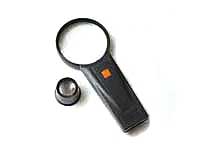 Besides all of the above, here's is some additional stuff you'll eventually need once you start finding stuff. First of all when you start locating those old coins, you got to have a magnifying glass or loope to check it out.
Besides all of the above, here's is some additional stuff you'll eventually need once you start finding stuff. First of all when you start locating those old coins, you got to have a magnifying glass or loope to check it out.
The large one has a light on it, and will light up what you are looking at when you press the orange button.
The small one is called a loope, and jewelers use these a lot. You can get a set of them cheap on Ebay. Get a 2X, 5X, and 10X. Any more magnified than that, and you won't be able to tell what it is that you found.
Plastic Containers for Finds
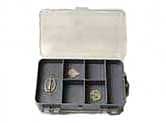 Then after you check it out, you need some kind of containers to keep all your treasure finds in. These plastic containers here are used for fishing lures. The small gray container is double sided, and we take it with us on the hunts.
Then after you check it out, you need some kind of containers to keep all your treasure finds in. These plastic containers here are used for fishing lures. The small gray container is double sided, and we take it with us on the hunts.
These plastic containers come in all different sizes at Walmart and they are cheap, so go pick one out. We get a new one every year to keep our finds in. They have slots you can adjust to fit to the size of your finds.
Batteries and Battery Charger
Also, last but not least, keep a good supply of batteries with you. We started out using regular AA's and then invested in some Nickel Metal Hydride batteries from Radio Shack and a battery charger. They lasted us a couple of years, and now were back to using Energizers AA's again. You can get a 30 pack at Home Depot for $15.00. There's nothing worse than getting all the way out to the field and having your batteries die.
Walkie Talkies
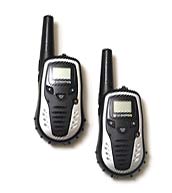 Our latest addition to our metal detecting accessories is a set of Walkie
Talkies.
Our latest addition to our metal detecting accessories is a set of Walkie
Talkies.
We got them at Walmart for $39.00, they have a six mile radius, and now we can talk to each other to see what we're finding, where the other person is, and when they are ready to leave. It saves us a lot of time and makes the hunt more enjoyable.